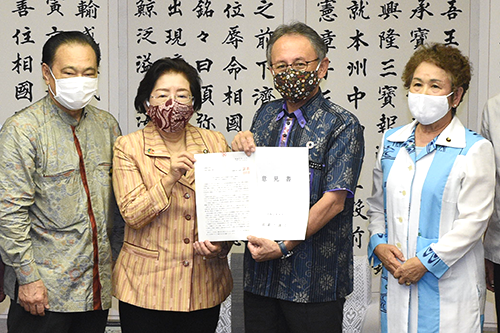OPG to form committee of civil engineers and other experts to look into opening 32nd Army underground trenches to the public

Naha Mayor Mikiko Shiroma (second from left) et al. petitioning Governor Denny Tamaki to preserve and open the 32nd Army headquarter trenches, around 1:30 p.m. on June 26 at the Prefectural Office
June 27, 2020 Ryukyu Shimpo
On June 26, Governor Denny Tamaki revealed a plan to form a new committee of experts this fiscal year to discuss the possibility of preserving and opening to the public the underground trenches built during the war under Shuri Castle and used as the headquarters of the Japanese military’s 32nd Army. His announcement was in response to Mikiko Shiroma, mayor, and Tomohiro Kudaka, head of the city council, of Naha and others who requested that the trenches be preserved and opened to the public. Governor Tamaki’s decision to form this committee will likely serve as a first step towards preserving the trenches that served as headquarters for the 32nd Army and opening them to the public.
Upon receiving the request, Governor Tamaki expressed the conventional view that “from the perspective of ensuring safety, given the possibility of falling rocks and lack of oxygen, it would be difficult to open [the trenches] to the public in their current state.” He then continued, “from the perspective of not allowing the war to be forgotten, I understand the importance of the role of the 32nd Army headquarter trenches in passing down history to the next generation. I hope to form a new committee to discuss how to preserve and open the trenches and transmit a message of peace, and consider the possibilities together with Naha City.” Vice Governor Kiichiro Jahana said, “I hope to see the committee discuss the ways in which [the trenches] can be preserved and opened to the public.”
When the committee will be established and when it will issue its conclusion have yet to be decided. Experts in civil engineering, the Battle of Okinawa, and various other fields will be selected to discuss the matter from different angles. The exact manner in which Naha City will be involved has not been decided yet. In 1997, the Prefectural Government formulated a “32nd Army Headquarter Trenches Preservation and Opening Master Plan”, but work towards maintenance and opening were suspended thereafter.
Mayor Shiroma et al. also requested that the governor call on the national government to gather human remains believed to remain in the trenches. “Even if it’s just a single bone, it’s important that it be returned to the surviving family members. If new materials concerning ungathered remains are obtained, I will provide them to the national government and endeavor to engage in dialogue with the national government to gather the remains,” said Governor Tamaki.
The 32nd Army was established in March 1944 for defense of Japan’s southwest islands. Construction of new headquarter trenches under Shuri Castle began in December 1944, and students who had been sheltering there were kicked out. The trenches span a total of one kilometer and are connected by five tunnels. It is said that more than one thousand soldiers, including General Mitsuru Ushijima and Lieutenant General Isamu Cho, resided in the trenches along with civilian employees of the military, students, women, and other Okinawans. As a base for the Japanese military, the trenches were fiercely attacked by the U.S. military, and on May 22, 1945, the Japanese military retreated to the south. These events all contributed to the tragic Battle of Okinawa in which Okinawan civilians too became victims of battle.
(English translation by T&CT and Sandi Aritza)
Previous Article:Editorial: Washington is concerned by Henoko plans—Tokyo should stop wasting time and taxpayer money
Next Article:Gov. Tamaki shares his mother’s words and lesson learned from WWII: ‘Life is precious’
[Similar Articles]
- More call for 32nd Army headquarters trenches under Shuri Castle to be opened to the public as castle is rebuilt
- Group submits proposal to preserve the 32nd Army Headquarters Shelter as a “peace education site,” Okinawa’s vice governor will look to discuss at investigative commission
- OPG to set up an explanation board about the former 32nd Army Headquarters Shelter at Shuri
- Governor Tamaki visits planned mining site in Komesu, Itoman amid concerns of human remains in soil to be used for Henoko reclamation
- Three university students urge pressure on government to protect remains of war dead
 Webcam(Kokusai Street)
Webcam(Kokusai Street)


